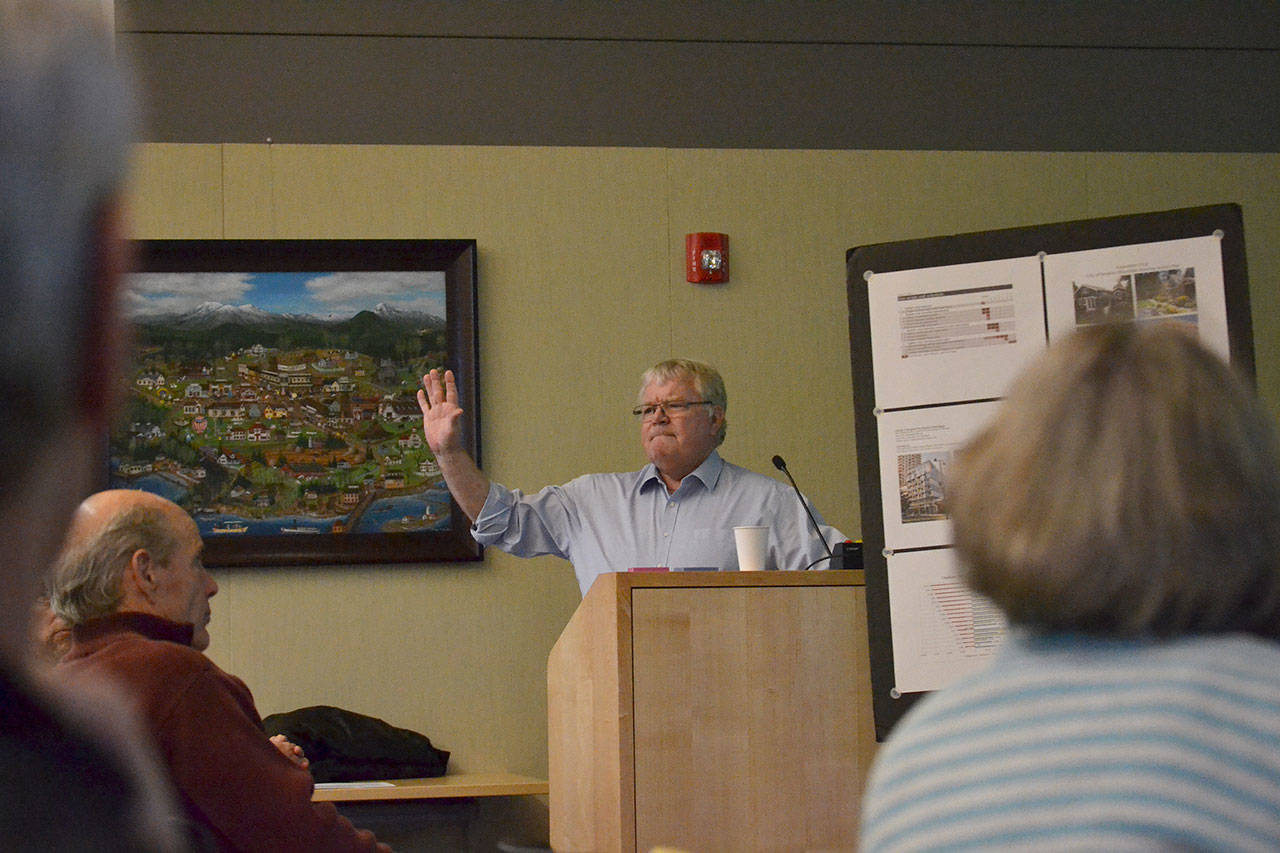By the numbers
1,700
Number of low-income options in Sequim
40%
Percentage of city residetns in workforce
12.9%
Percentage of city residents at or below poverty level (families: 9.6%)
$26,716
Individual residents’ mean per-capita income in Sequim (families: $58,497)
Data/demographics provided by consultants Tom Beckwith and Eric Hovee
In the coming months, Sequim leaders plan to consider a new Affordable Housing Action Plan that consultants say could impact residents’ way of life for years to come.
On Oct. 30, consultants Tom Beckwith and Eric Hovee presented to about 40 people in the Sequim Civic Center about Sequim’s demographics and current housing situation and what it could mean for affordable housing in the future.
The plan proposes 11 tasks, ranging from deferring building fees to proposing new types of developments in the city. Beckwith said cities typically use multiple elements to see more effectiveness in providing affordable housing.
The plan proposes the city use all or a combination of these:
• Establish different taxing rates for affordable housing purposes, i.e. freeze property values for a certain amount of time. Hovee said different cities target certain areas they might want to revitalize.
• Allow and encourage the use of innovative housing products and designs, i.e. allow land to be subdivided into smaller parcels for smaller homes like Katrina cottages and/or micro-housing at 220-300 square feet with centralized amenities.
• Implement an accessory dwelling unit program that drops the city’s requirement where the homeowner must live in the main home for someone to live in a smaller home behind the main home.
• Implement incentive zoning without cash offsets that allows smaller units with incentives in place for developers without a cost to city residents.
• Implement incentive zoning with cash offsets that defer fees such as impact fees.
• Package a demonstration property that displays some of these different types of homes in an area such as the Bell Creek Opportunity Zone by US Highway 101 and Sequim Avenue.
• Initiate a mixed-use project with 10-15 percent affordable units that goes through a competitive process.
• Refinance overextended households and establish an affordable housing deferred loan or shared equity program where the eligible homeowner’s house is acquired and sold back to them under terms they can afford within 30 percent of gross income devoted to housing occupancy costs.
• Renovate eligible housing with shared and limited equity loans programs, which Beckwith said keeps housing stock in good condition for when it’s turned over so it can be sold easier.
• Expand and capitalize a housing trust fund that’s dedicated to affordable housing.
• Update this plan frequently.
“This is a dynamic tool that affects you every day,” Beckwith said.
Beckwith said the plan is a standalone report that the city’s Comprehensive Plan can pull from for future updates, but first it must be approved by Sequim’s Planning Commission and then the City Council.
Statistics
Consultants said Sequim hosts more than 1,700 low income apartment options; some offer housing tax credits and rental assistance while others do not.
Only 40 percent of Sequim’s residents are in the workforce due to our high number of retirees, Hovee said, with a majority of Sequim’s workers commuting into the city, primarily in the service industry.
Beckwith said projections show Sequim’s 65-and-older population will continue to grow.
Individual city residents’ median per capita income is $26,716 per person and $58,497 for a family, consultants report.
Of the city’s population, 12.9 percent of residents live at poverty level while 9.6 percent of families live in poverty.
Estimates state 41 percent of people with a home pay more than 35 percent of monthly income towards a mortgage while 53 percent of renters are paying more than 35 percent of income for a home.
Hovee said if someone is paying more than 35 percent towards a home then another necessity is not being met.
Not enough data is available for the local impact for Airbnb’s, consultants said.
“It does hold up available units in the market,” Hovee said. “Even though it’s a six month market, it’s lucrative enough for them to continue.”
For more information on the Affordable Housing Action Plan, visit www.sequimwa.gov or call 360-683-4139.



